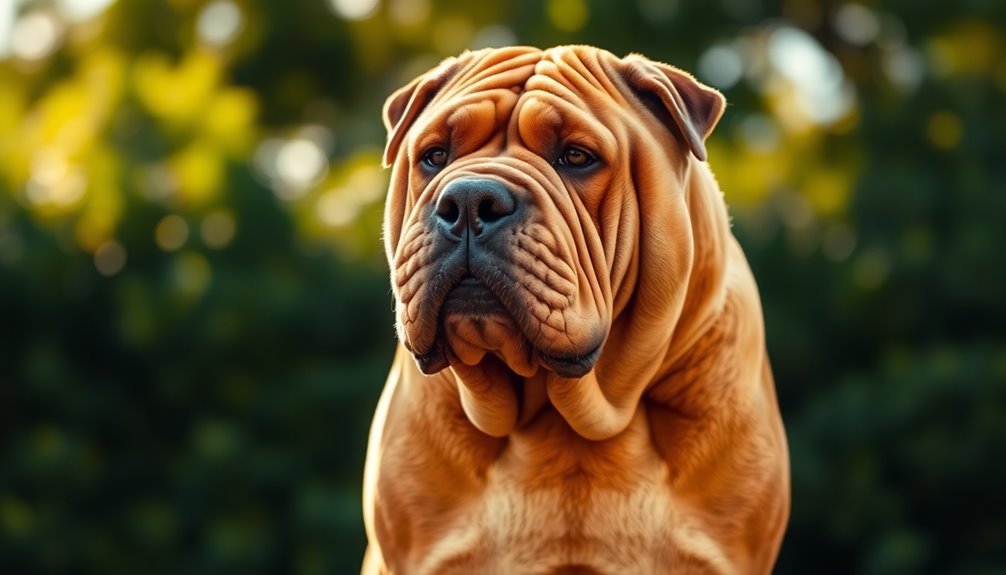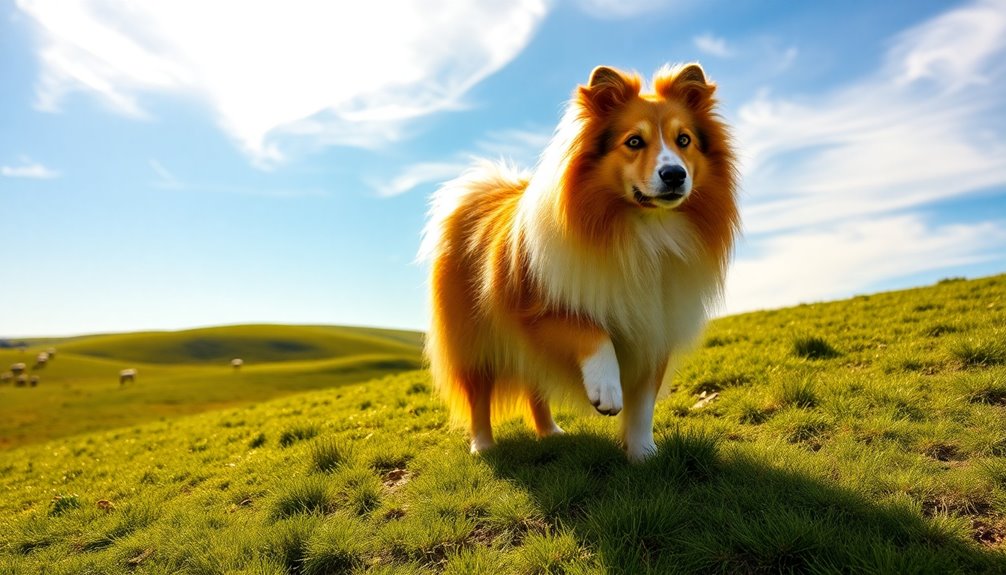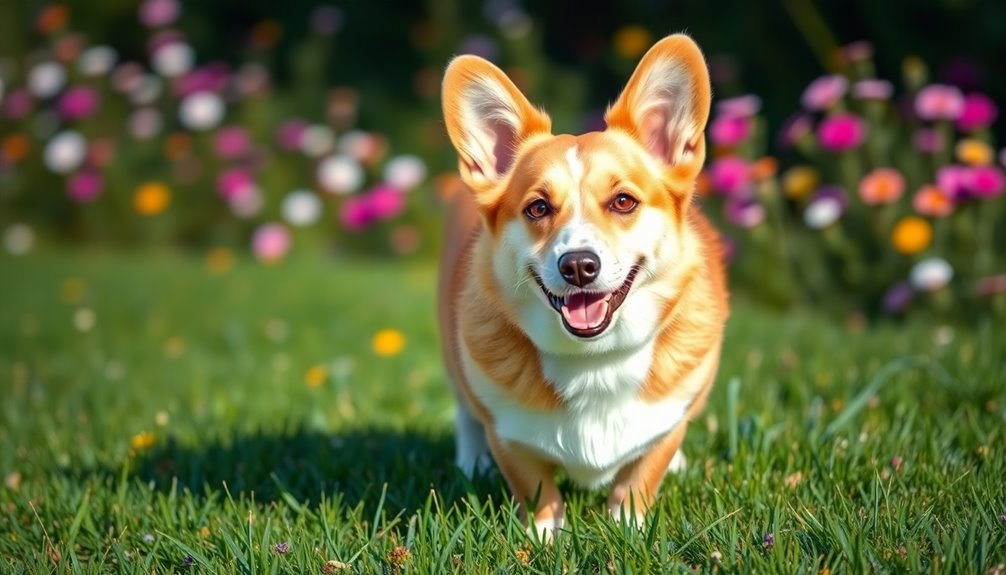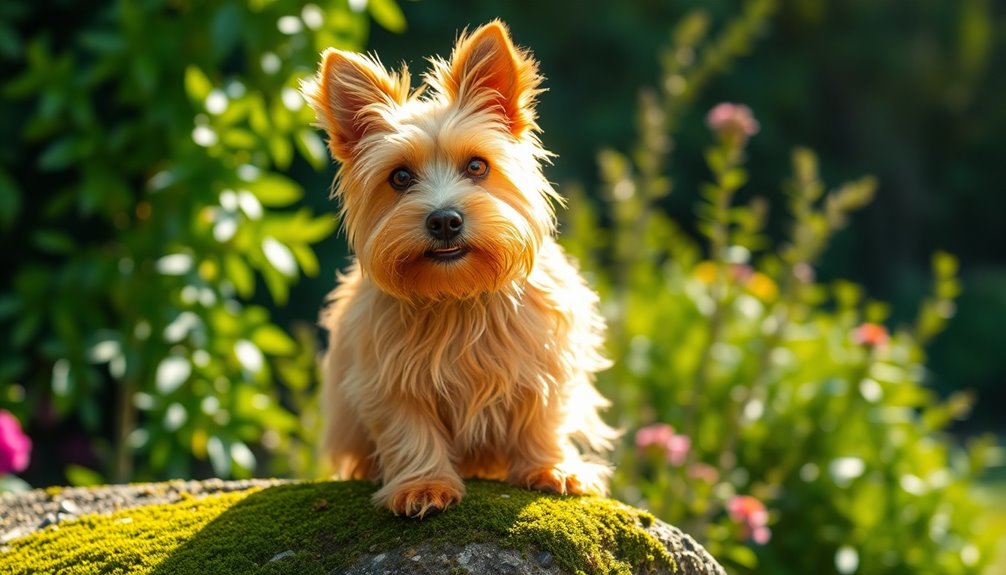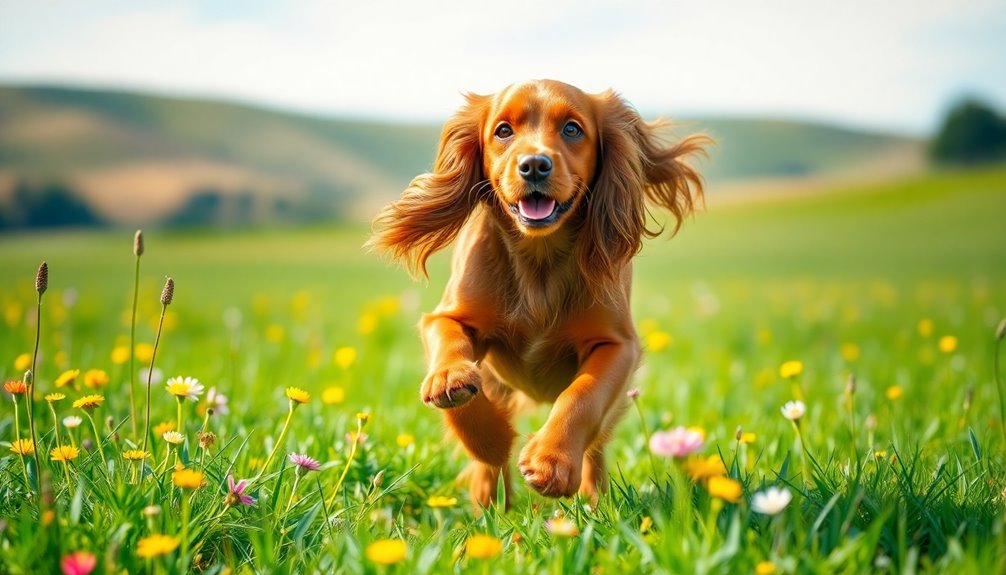The Shar-Pei is a unique and loyal guardian, known for its distinctive wrinkles and protective instincts. Originating in southern China, this breed was initially developed for guarding livestock and property. You'll appreciate their strong, compact build and thick coat in various colors. Their reserved nature around strangers makes them excellent watchdogs. Regular care is essential, including grooming and veterinary check-ups, especially due to their skin folds. With their intelligence and loyalty, Shar-Peis thrive in experienced hands. If you want to discover more about what makes them special, there's plenty more to learn about these captivating companions.
Key Takeaways
- The Shar-Pei is known for its distinctive wrinkled skin and loyal, protective nature, making it an excellent guardian.
- Originating from southern China, this breed has a rich history dating back to the Han Dynasty.
- Renowned for their guarding abilities, Shar-Peis possess intelligence, strength, and a menacing appearance that deters threats.
- Regular grooming and health care, including skin fold maintenance, are vital to their overall well-being.
- Socialization and early training are essential to mitigate aggression and ensure a well-adjusted temperament.
Introduction
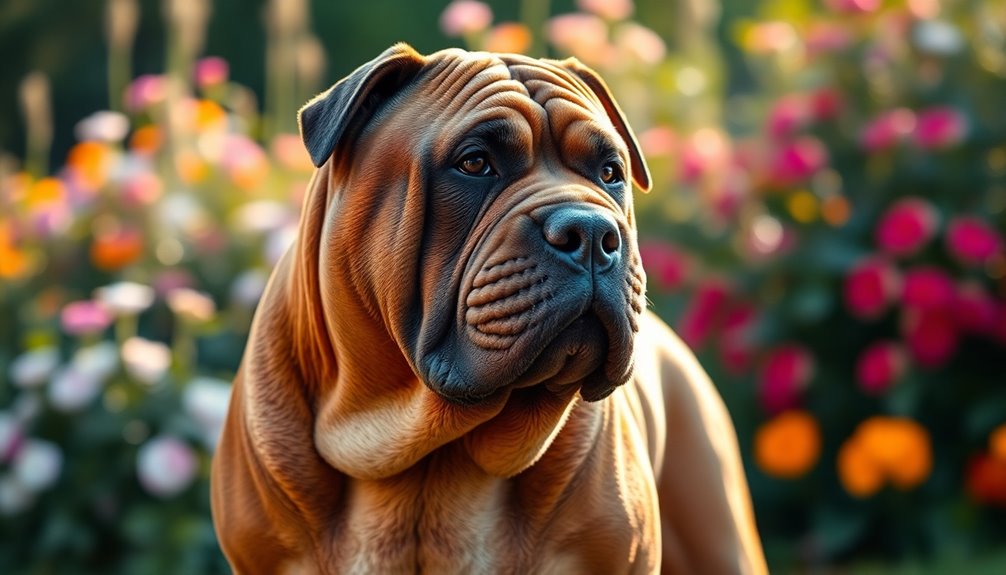
When you think of unique dog breeds, the Shar-Pei often stands out with its distinctive wrinkled skin and blue-black tongue. This breed boasts a compact stature, typically standing between 44 to 51 cm tall and weighing between 16 to 29 kg. Its short, harsh coat comes in a variety of solid colors, excluding white, with popular shades being black, red, fawn, and cream. The Shar-Pei's most recognizable features include its clam-shell ears, butterfly nose, and melon-shaped head.
Temperament-wise, Shar-Peis are known for their loyalty and protective nature. They can be reserved around strangers but are devoted and affectionate with their families. Their independent and strong-willed character often requires consistent obedience training and mental stimulation to thrive, making early socialization essential for their development.
When it comes to grooming, you'll need to commit to regular maintenance to keep their coat healthy and prevent infections in their wrinkles.
With moderate exercise needs, Shar-Peis adapt well to apartment living but should avoid overexertion in hot weather. Overall, owning a Shar-Pei means embracing a unique companion that's both loving and spirited, ensuring a fulfilling relationship.
History and Origin
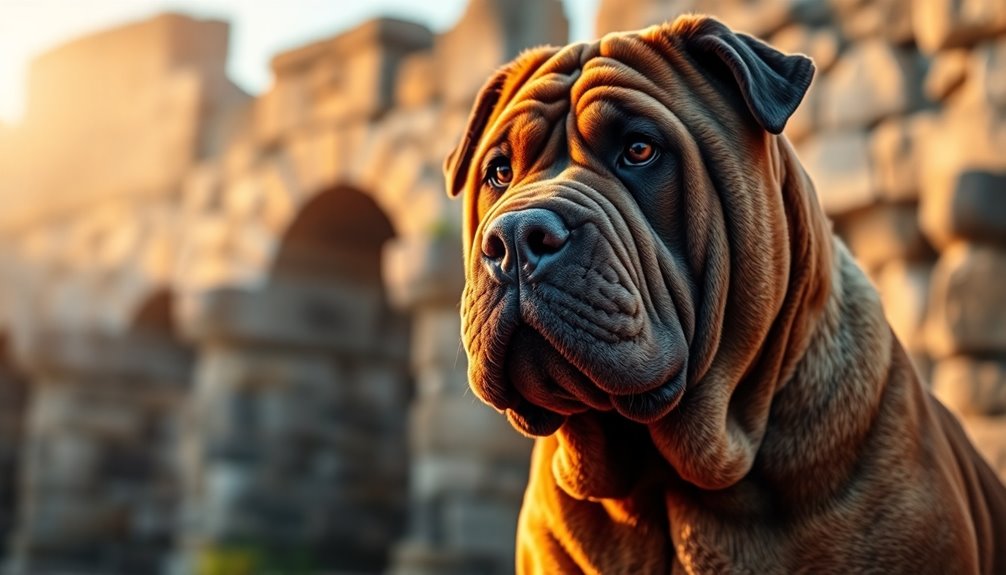
The Shar-Pei originated in southern China, specifically in villages like Tai Li in Kwangtung Province, dating back to the Han Dynasty. Bred primarily for guarding livestock and property, these dogs played crucial roles for farmers and peasants. Their unique features and loyal nature made them invaluable protectors in their early days. The breed's name, which translates to "sand-skin(1)," reflects its distinctive coat texture that further enhanced its role as a guardian.
Where and when the breed originated
Shar-Pei dogs, known for their distinctive wrinkles and unique blue-black tongues, trace their origins back to the area around Tai Li in Kwangtung Province, China, during the Han Dynasty, around 200 B.C. Statues resembling these dogs were discovered, confirming their presence in ancient times. They were mentioned in a 13th-century Chinese manuscript that described a wrinkled dog with similar characteristics, highlighting their long history.
Primarily developed as a working breed in the southern provinces of China, the Shar-Pei was influenced by the introduction of mastiff-type dogs from the West. The breed shares common ancestors with Chow Chows and Mastiffs, which is evident in their physical traits. "Shar-Pei" translates to "sand-skin," referring to their rough, sandy coat that distinguishes them from other breeds. Additionally, the Shar-Pei was initially used for hunting, herding, and sentry work, showcasing their versatility and importance in traditional Chinese society.
Despite facing significant decline during the Chinese Communist Revolution, where high taxes and breeding bans threatened their existence, a few dedicated breeders in Hong Kong and Taiwan worked to preserve the breed.
Guarding Livestock and Property
Originally bred for their guarding abilities, Shar-Pei dogs played a vital role in protecting livestock and property in ancient China. As a farmer, you'd rely on these loyal companions to guard your herd against predators and poachers.
Their unique traits—intelligence, strength, and stamina—made them excellent herders and protectors. With their menacing appearance and "Warrior Scowl," they could easily frighten off potential threats.
Shar-Pei weren't just guardians; they also served as utility dogs, hunting wild boar and other game to support farm life. Their calm demeanor and fierce loyalty made them invaluable to families. Interestingly, they possess a blue-black tongue, a trait they share with the Chow Chow, which adds to their unique physical characteristics.
While they were historically used in dog fighting due to their physical attributes, it's important to note that they weren't inherently aggressive.
Unfortunately, they faced near extinction in the 20th century due to government restrictions in China. Thanks to efforts by enthusiasts like Matgo Law, the breed was saved and eventually recognized by the American Kennel Club in 1992.
Today, while they make loving family pets, their protective instincts remain strong, requiring experienced owners to manage their loyalty effectively.
Physical Characteristics
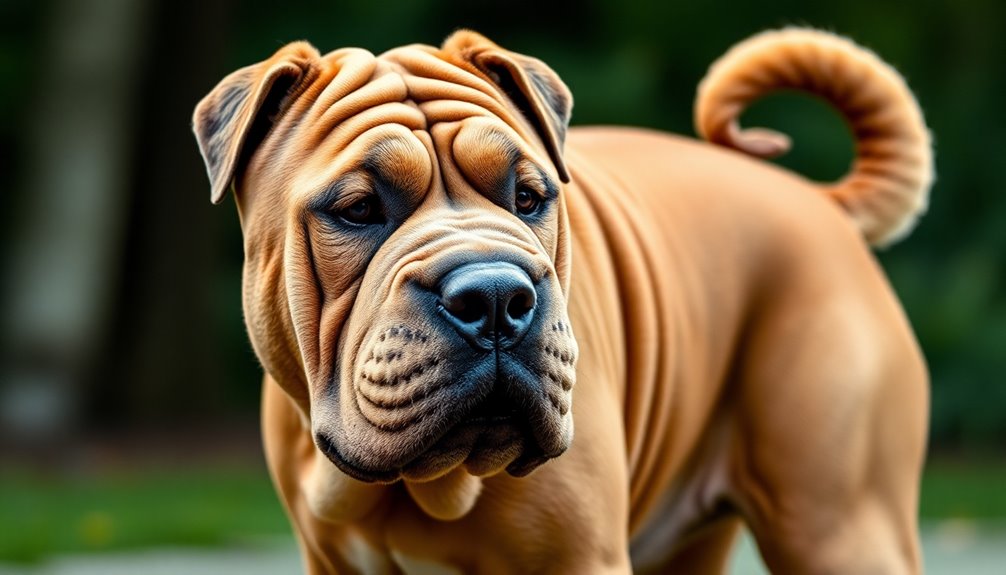
When you look at a Shar-Pei, you'll notice their unique size and weight, typically ranging from 44 to 51 cm in height and 16 to 29 kg in weight. Their short, harsh coat can come in a variety of solid colors, showcasing their striking appearance. This breed is available in 20 colors, each contributing to their unique charm. With prominent, deep-set eyes, these dogs exude a distinctive charm that sets them apart from other breeds.
Size, weight, and coat details
The Shar-Pei is a medium-sized breed known for its distinctive wrinkled appearance and sturdy build. Males typically stand between 18 to 20 inches at the shoulder, while females range from 17 to 19 inches. In terms of weight, adults usually weigh between 45 to 60 pounds.
You'll notice that they experience rapid growth in their first year, reaching nearly full height by around one year of age. This breed typically achieves its full adult size by the age of three.
When considering the coat, the Shar-Pei can come in three types: horse, brush, and bear. The horse coat is extremely short and rough, while the brush coat is slightly longer, up to one inch. The bear coat resembles that of the Chow and is the longest of the three. Regardless of type, the coat isn't shiny and has a harsh texture.
Colors vary widely, including solid shades like red, black, cream, and fawn. Maintaining the coat is crucial; it shouldn't be trimmed, and excessive folds of skin can disqualify your dog from shows.
Be mindful that some people may develop an allergy to the prickly texture, so it's worth considering before bringing a Shar-Pei into your home.
Prominent, Deep-Set Eyes
While many breeds showcase unique eye shapes, the Shar-Pei's prominent, deep-set eyes stand out distinctly. These small, sunken eyes, framed by a narrow ocular opening, give the breed its characteristic expression.
However, their deep-set nature means there's limited support for the eyelids, which can lead to various eye issues, notably entropion. This condition causes the eyelids to turn inward, resulting in eyelashes and facial hairs rubbing against the eye, leading to irritation and potential pain. Notably, Shar Pei are reported to be 131 times more likely to develop entropion compared to average dogs.
You might notice symptoms like squinting, excessive tearing, or redness. If your Shar-Pei shows these signs, it's essential to consult a vet, as uncorrected entropion can result in severe complications like corneal damage or even blindness.
Surgical options such as eye tacking or entropion surgery can help alleviate these issues, but without intervention, the risk of chronic irritation and corneal scarring increases.
Thus, while you're captivated by your Shar-Pei's deep-set eyes, keep an eye out for potential problems. Regular vet check-ups can ensure your loyal companion maintains healthy vision for years to come.
Temperament and Personality
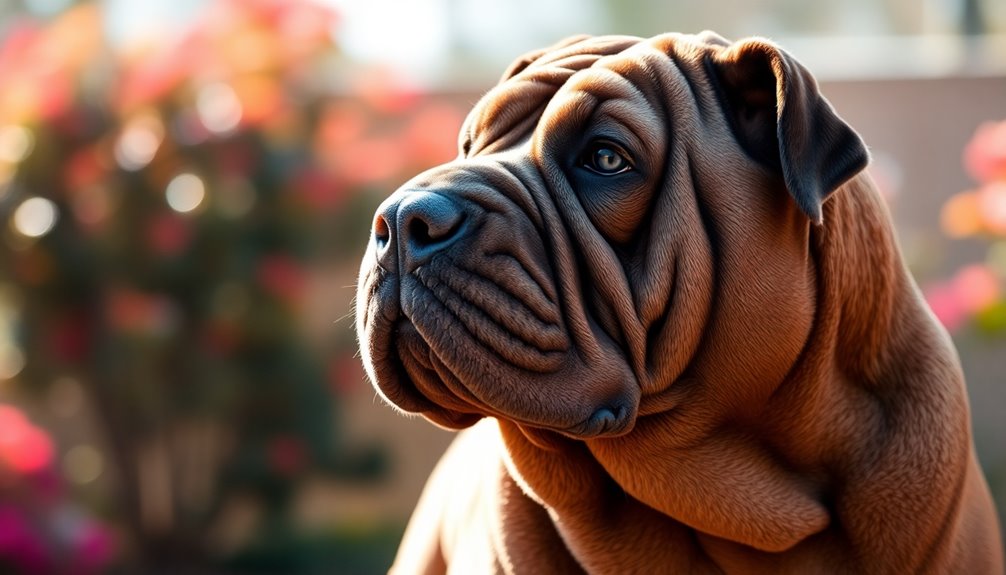
The Shar-Pei is known for its unwavering loyalty and protective instincts, making it a devoted companion for families and individuals alike. While they can be aloof with strangers, their strong bond with you ensures they're vigilant guardians of your home. With the right socialization, they can also coexist peacefully with other pets, enhancing the family dynamic. Regular grooming is essential to maintain their overall hygiene, as their skin folds can trap moisture, leading to infections. Additionally, a balanced diet that includes nutrient-rich ingredients can further support their health and vitality.
Protective and Devoted Nature
A Shar Pei's protective and devoted nature makes it a remarkable companion for those seeking a loyal guardian. With a strong instinct to protect, these dogs are deeply connected to their families, stemming from their historical role as guard dogs. When they perceive a threat, they won't hesitate to defend their home and loved ones, showcasing their territorial instincts.
You'll find them alert and vigilant, quickly sensing unusual sounds or movements, which makes them exceptional watchdogs. Their loyalty is unwavering; once a bond is formed, they become fiercely devoted companions. You'll appreciate their attentiveness, as they're responsive to your commands and cues, often preferring your company over that of other dogs. This loyalty can manifest in protective behaviors, like positioning themselves between you and perceived threats or growling at strangers.
To fully harness their protective instincts, early socialization and training are essential. Proper guidance helps them distinguish between genuine threats and benign situations, ensuring they remain confident and well-adjusted. Furthermore, their distinctive wrinkled skin requires regular cleaning to prevent skin issues, which can also affect their overall comfort and well-being.
With the right approach, your Shar Pei will be an alert and devoted guardian, always ready to keep you safe.
Suitability for families, individuals, or other pets
Often regarded as loyal companions, Shar-Peis fit well into various living situations, whether with families, individuals, or other pets. Their calm and self-assured demeanor makes them a great match for families, even in apartments, as they don't require excessive exercise. Additionally, their low exercise needs make them suitable for those who may not have a lot of time for long walks. Providing emotional support is important for families navigating any changes, including the introduction of a new pet.
With early socialization, they bond deeply with family members, but you'll need to manage their strong-willed nature through consistent training.
For individuals, Shar-Peis are independent enough to handle your occasional absence, but they still crave mental stimulation and companionship. Their stubbornness means you'll need to be assertive with training to ensure they behave well.
When it comes to other pets, early socialization is crucial. Without it, they may show aggression toward unfamiliar dogs. Some mixes, like the Sharp Eagle, mightn't be suitable for homes with small animals due to their prey drive.
However, with proper introductions, they can coexist peacefully with breeds like Chows. Ultimately, whether you're a family, single, or have other pets, a Shar-Pei can adapt well if you provide the right environment and training.
Health and Lifespan
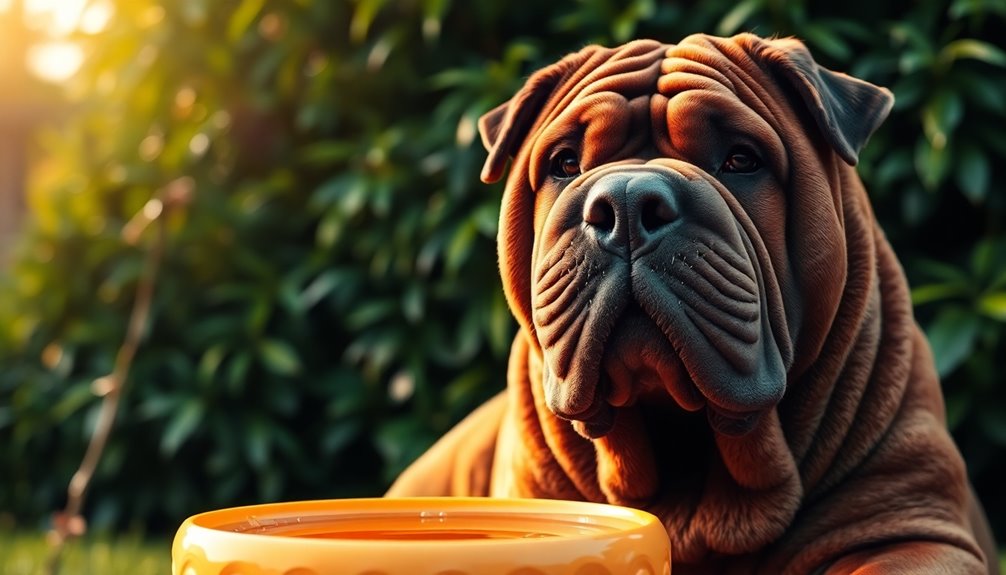
When it comes to your Shar-Pei's health and lifespan, you're looking at an average of 8 to 12 years, though some live much longer with the right care. This breed is prone to specific health issues, including skin infections and eye problems, so staying proactive is key. Regular veterinary care, including check-ups and vaccinations, is crucial for early disease detection to enhance their longevity.
Typical lifespan of the breed
The typical lifespan of a Shar-Pei ranges between 8 to 12 years, although some can live longer with the right care. Factors like genetics, lifestyle, and overall health play crucial roles in determining how long your Shar-Pei will be by your side.
Interestingly, the oldest known Shar-Pei lived to be 18 years old, showcasing that with proper attention, longevity is achievable.
To maximize your dog's lifespan, focus on a balanced diet rich in nutrients. Regular exercise is essential to maintain a healthy weight and prevent obesity-related diseases. Routine veterinary visits are vital for early detection and management of potential health issues, as early detection can significantly improve treatment outcomes.
You should also create a safe and comfortable environment, as this contributes positively to your dog's well-being.
Mental stimulation and socialization are equally important, as they can enhance your Shar-Pei's overall health. Providing access to clean water, shelter, and protection from extreme temperatures is crucial.
Lastly, when choosing a puppy, consider selecting a reputable breeder who conducts genetic testing to minimize health risks. With your commitment to their care, your loyal companion can enjoy a long and happy life.
Common health concerns or genetic predispositions
Maintaining a healthy lifespan for your Shar-Pei involves being aware of common health concerns and genetic predispositions that can affect their well-being.
One significant issue is the breed's predisposition to skin conditions due to overproduction of hyaluronan, linked to a mutation near the HAS2 gene. This can cause thickened, wrinkled skin and is associated with periodic fever syndrome, which triggers fever and inflammation. The genetic cause of these skin and fever traits has been identified through international research.
Another concern is Shar-Pei Autoinflammatory Disease (SPAID), characterized by recurrent fever episodes, arthritis, and other inflammatory symptoms. Genetic testing can help you identify your dog's risk for SPAID, categorizing them as non-carriers, single carriers, or double carriers, with double carriers being more susceptible.
Additionally, be aware of bloat (Gastric Dilatation and Volvulus), which can be fatal if not treated promptly. Signs include an enlarged abdomen and unproductive retching—immediate veterinary intervention is essential.
Lastly, some Shar-Peis may face nutritional absorption issues due to genetic defects, leading to stunted growth. Monitoring their diet and health can help manage these conditions effectively.
Tips for maintaining health and wellness
Regularly prioritizing your Shar-Pei's health and wellness can significantly enhance their quality of life and longevity. Start with a high-quality diet that includes proteins, fats, carbohydrates, vitamins, and minerals. Feeding them two to three smaller meals daily aids digestion. Consider adding Omega-3 fatty acid supplements for skin and joint health.
Transition their diet according to life stages: puppy formula for the first year, adult formula thereafter, and a senior diet at seven years.
Ensure your Shar-Pei gets at least an hour of exercise daily, mixing walks, playtime, and training sessions. This helps maintain a healthy weight and reduces the risk of heart disease and joint issues. Secure your garden to prevent escapes due to boredom. Due to their high prey drive, it's crucial to supervise outdoor playtime, especially around smaller pets.
For skin and coat care, clean their skin folds regularly and check for infections at least twice a week. Use a medicated shampoo if needed and brush their coat weekly.
Routine veterinary check-ups are crucial for early detection of health issues. Incorporate mental stimulation through puzzle toys and socialization, creating a comfortable and stress-free environment to improve overall well-being.
Care Requirements
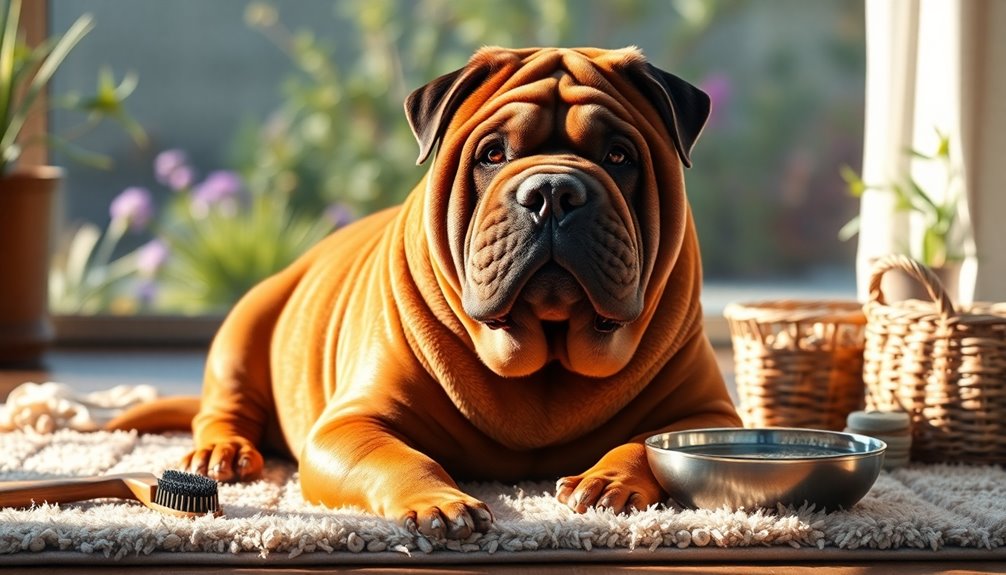
Caring for your Shar-Pei involves understanding their unique needs, from minimal brushing to their exercise requirements. Regular bathing is also essential for maintaining their skin and coat health, as they have loose, wrinkly skin that requires special attention. You'll want to ensure they get enough activity to match their energy levels while also paying attention to their diet for optimal health. Let's explore how to keep your wrinkled guardian happy and healthy.
Minimal Brushing Required
For the Shar-Pei, minimal brushing is all you need to keep their coat healthy and vibrant. Brushing once a week is sufficient to remove dead hair and stimulate their skin. Use a soft-bristle brush or a rubber grooming mitt, but be gentle—Shar-Peis have sensitive skin, and you don't want to irritate it. This weekly routine can also serve as a great bonding time between you and your dog.
In addition to brushing, pay close attention to their skin folds. Check them at least twice a week for signs of infection, like redness or odor. After baths or any exposure to water, ensure the wrinkles are thoroughly dried, as moisture can lead to skin issues. Daily cleaning of these wrinkles with a damp cloth is crucial, followed by complete drying. Regular skin checks can help catch any potential problems early on.
When it comes to bathing, do it every 6-12 weeks with a gentle dog-specific shampoo. Avoid over-bathing to prevent stripping their natural oils.
Regular nail trimming every 3-4 weeks and weekly ear checks will also keep your Shar-Pei looking and feeling their best. With these simple care requirements, you'll maintain your Shar-Pei's unique charm effortlessly.
Exercise requirements and energy levels
Shar-Peis thrive on a consistent exercise routine that combines daily activities with mental stimulation. Aim for 30 minutes to 1 hour of exercise each day, which you can split into two or three shorter sessions. They enjoy leisurely walks, short hikes, and playtime in a secure yard.
Avoid high-intensity activities to prevent joint stress and overheating, as they've moderate energy levels and prefer steady, moderate activities. You can engage your Shar-Pei in short bursts of play, but they don't require intense exercise.
Keep in mind that energy levels may decrease with age, so adjust activities accordingly. For mental stimulation, obedience training is beneficial, and puzzle toys can keep their minds engaged. Interactive games like fetch, tug-of-war, and hide-and-seek are also great options. Regular exercise is essential for their overall well-being and helps alleviate potential behavioral issues.
Be mindful of heat sensitivity; exercise during cooler parts of the day and ensure they stay hydrated. Also, puppies need controlled exercise to avoid joint damage, while senior dogs benefit from shorter, less frequent sessions.
Regular exercise helps monitor their health, so pay attention to changes in their gait or energy levels.
Feeding tips and diet recommendations
Nutrition plays a vital role in maintaining your Shar-Pei's health and well-being. Focus on providing high-quality protein like chicken, turkey, or fish to support muscle maintenance. Balance this with healthy fats for energy and skin health, and include moderate carbohydrates for energy without risking obesity. Essential vitamins and minerals are crucial for overall health, so choose a well-rounded diet. Additionally, incorporating freeze-dried food into their meals can help retain nutrients while providing high animal protein.
For portion control, aim for 800 to 1350 calories daily, depending on your dog's age, weight, and activity level. This typically translates to 1.5 to 2.5 cups of dry food divided into two meals. Puppies should eat three to four times a day, while adults do well with two meals. Regularly check your dog's weight and adjust portions as needed.
If your Shar-Pei has special dietary needs, consider a grain-free or raw food diet after consulting with a veterinarian. Supplements like glucosamine, chondroitin, and probiotics can also be beneficial.
Lastly, ensure your dog has access to fresh water and high-moisture foods to maintain hydration and prevent kidney issues. Regular vet check-ups will help you monitor your dog's nutritional needs effectively.
Training and Socialization
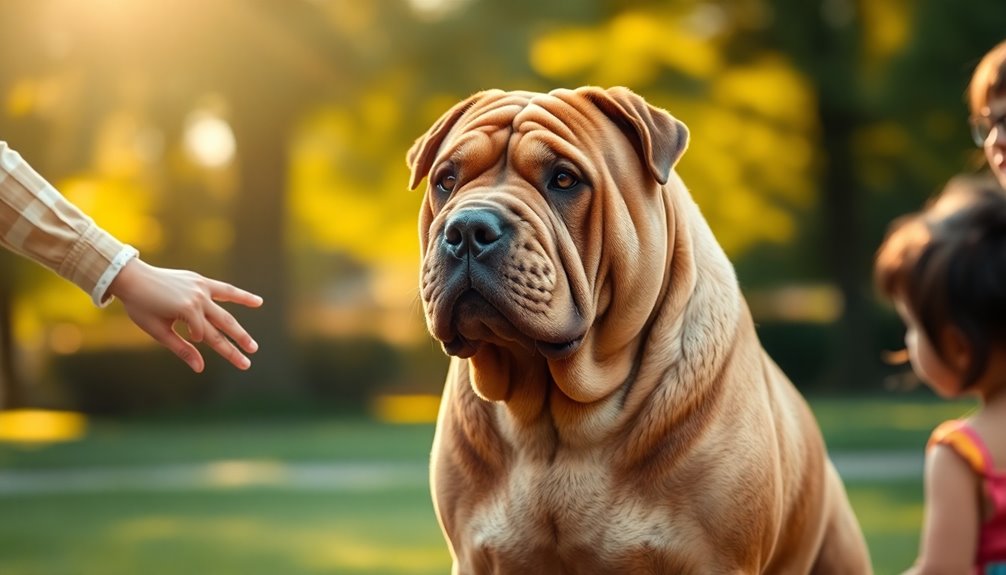
Training your Shar-Pei requires a moderately independent approach, as these dogs often think for themselves. Gradually introducing them to new friends helps build their confidence and reduces leash reactivity towards strangers. To aid in their development, it's essential to start training early so they can learn basic commands and establish good behavior from a young age.
Moderately Independent Training Style
When it comes to training a Shar-Pei, adopting a moderately independent training style can be highly effective. Start early to establish clear boundaries and expectations, focusing on basic commands like "sit," "stay," and "come." Consistency is crucial—make sure everyone in your household uses the same commands and rewards to avoid confusion.
Using positive reinforcement is key. Reward desired behaviors with praise, treats, or playtime. This approach helps your dog associate good behavior with positive outcomes, encouraging them to repeat those behaviors. Remember, harsh training methods can lead to resistance or fear, so stick to gentle, positive techniques. Immediate rewards reinforce learning effectively. Additionally, regular socialization from a young age is essential to reduce potential aggression and establish good behavior, as Shar Peis are known to be reserved with strangers. Engaging in this positive reinforcement method not only builds trust but also strengthens your bond with your pet.
Establish a regular training routine, with sessions lasting 10-15 minutes, two to three times a day. This helps your Shar-Pei understand what's expected of them.
Be patient and adaptable, as their independent nature may require you to adjust your methods. Stay calm during training sessions, and set realistic expectations for your dog's progress.
Gradual Introductions to New Friends
Introducing your Shar-Pei to new friends should be a gradual process that minimizes stress and fosters positive experiences. Start by introducing your puppy to a few calm individuals in a controlled environment, like a quiet park or a friend's backyard. This prevents overwhelming your puppy and allows for more manageable interactions.
Make sure your puppy meets people of different ages, sizes, and ethnic backgrounds. Use positive reinforcement—treats and praise—to encourage calm behavior. Gradually increase the number of new people and their diversity once your puppy feels comfortable. Proper socialization is essential for developing a well-adjusted adult dog.
When it comes to other dogs, arrange playdates with friendly, vaccinated pups in a controlled setting. Monitor your Shar-Pei's reactions and keep initial play sessions short, extending the duration only as they adjust. Avoid forcing interactions if you notice any signs of discomfort.
Additionally, expose your puppy to various environments, like pet stores or outdoor cafes, while keeping them on a leash. Gradual exposure to different sounds and objects is equally essential to build their confidence.
This thoughtful approach will help your Shar-Pei develop positive relationships with friends and enhance their social skills.
Leash Reactivity Towards Strangers
For many Shar-Pei owners, leash reactivity towards strangers can be a challenging issue that arises from fear, frustration, or excitement. This reactivity manifests as intense barking, lunging, or pulling on the leash, driven by emotional states. Understanding the root causes is essential; often, fear stems from a lack of socialization or negative past experiences.
If left unaddressed, this reactivity can escalate to aggression. To tackle this, implement positive reinforcement techniques to encourage calm behavior. Keep your training sessions short—about 5 to 10 minutes—to maintain your dog's focus. Practice loose leash walking and reward your Shar-Pei for staying close to you. Establish a "quiet" command to manage barking and other reactive behaviors effectively. Fear-based reactivity is often linked to a dog's overall emotional state, making it vital to address these underlying issues during training.
Socialization is crucial. Expose your Shar-Pei gradually to various environments and people from a young age to develop a well-rounded temperament. A stable routine enhances their emotional well-being, making them more adaptable in different situations.
Ideal Living Environment

If you're considering a Shar-Pei, a spacious home with a secure yard is ideal for their well-being. They're sensitive to heat, so living in humid climates requires extra attention to keep them cool and comfortable. Regular check-ups are essential to monitor for breed-specific health issues.
Spacious Home With Secure Yard
While Shar-Peis can adapt to various living environments, having a spacious home with a secure yard significantly enhances their quality of life. A roomy home gives your Shar-Pei the freedom to move around and engage in play, while a secure yard provides a safe space for exercise.
Although they can thrive in apartments, a yard is beneficial for their well-being. To keep your Shar-Pei happy and healthy, aim for about 30 minutes to an hour of exercise daily. This can include leisurely walks or short play sessions in the yard. Since they may bark at passing pedestrians or cars, consider the noise level in your living area. A securely fenced yard is essential to prevent escapes and ensure safe playtime. Additionally, using non-irritating tear stain remover products helps maintain their skin folds and overall hygiene, which is crucial for their health.
Also, early socialization is key. Engaging your Shar-Pei in structured activities helps them become friendly and adaptable. Remember to keep them on a leash around unfamiliar people or dogs.
With adequate space, regular exercise, and proper training, your Shar-Pei will thrive, strengthening the bond you share and enhancing their loyal nature.
Heat Sensitivity in Humid Climates
Shar-Peis can struggle with heat and humidity, making it crucial to create an ideal living environment that accommodates their needs. These dogs are extremely sensitive to high temperatures, so providing plenty of shade when they're outside is essential. Additionally, their moderate grooming requirements mean that regular inspections of their skin folds are necessary to prevent infections exacerbated by heat.
Avoid vigorous exercise during warm weather, as it can lead to overheating. Instead, schedule daily walks in the cooler parts of the day, ensuring your furry friend stays safe from heat stress. It's vital to monitor your Shar-Pei closely for signs of overheating, like panting or lethargy. Keep fresh, cool water available at all times, and offer regular breaks in shaded areas during outdoor activities.
If you notice signs of overheating, use cool water to help lower their body temperature. In hot climates, the wrinkles on their heads can trap heat, so it's crucial to clean and dry those folds thoroughly to prevent skin infections.
Using fans or air conditioning can help keep your Shar-Pei comfortable indoors. Always avoid leaving them in vehicles or enclosed spaces without ventilation.
Ancient Chinese Royal Companions

As you explore the Shar-Pei's history, you'll find its ancient role as a battle companion for Chinese royalty fascinating. This breed not only served in royal settings but also captured modern attention, like the memorable dog from Hollywood's "The Hangover." Understanding these aspects highlights the Shar-Pei's unique blend of cultural significance and contemporary popularity. The Shar-Pei was originally bred as a general utility dog, serving various roles such as hunting and guarding livestock in ancient China.
Ancient Breed Used in Battles
In ancient China, the Shar-Pei wasn't just a loyal companion; it was a fierce protector used in battles and royal duties. Originating around 200 B.C. in the village of Tai Li, these dogs were bred for multiple roles. They served as herders, hunters, and guardians of livestock, but their most notable function was as protectors of the royal family and palace.
With their loose, wrinkled skin, Shar-Peis were designed to withstand physical confrontations. This unique feature allowed them to escape from an opponent's grip, while the prickly folds discouraged attackers. Their blue-black tongues added to their fearsome appearance, making them look more intimidating in confrontations. Compact and muscular, they were ideal for guarding properties and deterring poachers. Loose skin reflects their historical role as a guardian, providing protection in dangerous situations.
As time passed, the Shar-Pei also found a place in the brutal world of dogfighting, showcasing their loyalty and tenacity. Even in the face of adversity, these dogs remained steadfast protectors, embodying the spirit of guardianship that defined their role in ancient Chinese society.
Their legacy as fierce protectors lives on, reminding us of their noble beginnings in royal and battle settings.
Hollywood's "The Hangover" Dog
With their unique looks and loyal temperament, the Shar-Pei captured the hearts of many, including Hollywood filmmakers. In the hit movie "The Hangover," a Shar-Pei named "Mister Chow" became an unforgettable character, showcasing the breed's distinctive features and playful spirit. This film not only highlighted the dog's charm but also introduced a broader audience to the history and significance of the Shar-Pei.
Originating around 200 B.C. in China, Shar-Pei were initially bred to guard royal palaces and protect the royal family. Their unique wrinkled skin served a practical purpose, allowing them to escape from opponents during dogfights, while their firm bite was essential for guarding livestock. The blue-black tongue, a shared trait with Chow Chows, added to their fierce appearance. Additionally, the breed's intense loyalty and protective instincts make them excellent family guardians. The Shar-Pei's history as royal companions reflects their longstanding bond with humans and underscores their importance in ancient Chinese culture.
Despite facing near extinction in the 1940s, due to harsh policies, their appearance in popular culture helped revive interest in the breed. Today, the Shar-Pei is cherished not just as a guardian but also as a loyal family companion, embodying the rich history that connects them to ancient China.
Their journey from royal protectors to Hollywood stars is a testament to their enduring appeal.
Ideal for Experienced Owners?
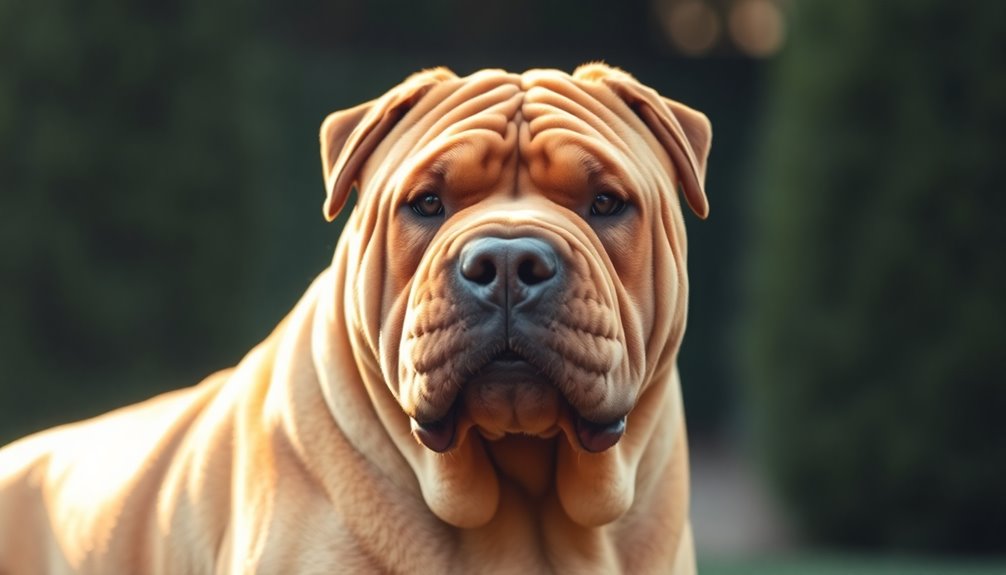
If you're considering a Shar-Pei, keep in mind they're not ideal for first-time owners.
Their stubborn nature and grooming needs require a committed, experienced pet parent who can handle their unique challenges. Regular veterinary check-ups are essential for monitoring their health status, as Shar-Peis are prone to common health conditions. You'll need to be prepared for regular grooming and understanding their body language to ensure a happy and healthy relationship.
Not Ideal for First-Time Owners
Many potential dog owners might find that a Shar-Pei isn't the ideal choice for their first pet. These dogs possess a strong-willed nature that can be challenging for novice owners. While they're intelligent, their stubbornness means you'll need to be patient and consistent with training.
Starting early with positive reinforcement methods, like praise and treats, is essential. Enrolling in professional socialization and obedience classes can help you navigate their independent spirit. Additionally, their protective instincts may lead them to be suspicious of strangers, requiring extra training to ensure they're well-mannered around visitors. Shar-Peis often don't get along with other dogs, particularly same-sex ones, which can complicate social situations.
On top of training, you'll need to monitor their health closely. Regular ear cleaning and skin fold checks are crucial to prevent potential issues. Their unique physique makes them prone to overheating in warm weather, so you'll need to be vigilant in warm weather.
Given these factors, Shar-Peis are best suited for experienced owners who can commit to their training and care needs, ensuring a happy and healthy life for these loyal companions.
Commitment to Regular Grooming
Keeping up with the grooming needs of a Shar-Pei requires dedication and consistency, making it essential for experienced owners.
You'll need to brush their short, dense coat once a week using a soft bristle brush or grooming glove to remove dead hair and promote healthy skin. While Shar-Peis shed minimally, expect more shedding during fall and spring. Bathing every 6-8 weeks with a dog-friendly shampoo will keep their coat clean.
Don't forget to maintain those iconic wrinkles. Clean the skin folds every other day with a baby wipe or wet cloth to prevent fungal infections. Check for signs of infection like redness or odors, and consult your vet if you notice anything unusual. The Shar Pei's coat type can also influence grooming frequency, making it important to be aware of their specific needs.
Ear and dental care are equally important. Check their ears weekly for irritation and clean them with a vet-recommended solution. Brush their teeth several times a week, or use dental chews if they resist brushing.
Finally, trim their nails every 3-4 weeks and ensure regular vet check-ups to keep your Shar-Pei healthy and happy. This commitment to grooming is vital for their overall well-being.
Frequently Asked Questions
Do Shar-Peis Shed a Lot?
No, Shar-Peis don't shed a lot. They shed seasonally, mainly in the fall and spring, as they prepare for a new coat.
You'll notice more hair during these times, but it's manageable. Regular brushing once a week keeps the shedding under control.
Both coat types, horse and brush, require similar grooming, so a bit of effort on your part can help keep your home free from excessive pet hair.
How Much Exercise Do Shar-Peis Need Daily?
Shar-Peis need about 30 minutes to an hour of exercise each day. You can split this into two or three shorter sessions to avoid overexertion.
Daily walks, preferably in the morning and evening, are ideal. For puppies, keep play sessions shorter and more frequent, while senior dogs require gentler, shorter walks.
Always consider the weather and your dog's health when planning their exercise routine to ensure they stay comfortable and safe.
Are Shar-Peis Good With Children?
Are Shar-Peis good with children? It depends on several factors.
While they're loyal and protective, their strong-willed nature can make interactions with young ones tricky. Early socialization and consistent training are crucial to foster a positive relationship.
You'll need to supervise their interactions closely, especially with kids. If your children are older and can respect boundaries, a well-trained Shar-Pei can become a loving family companion.
Always prioritize safety and supervision.
What Is the Average Weight of a Shar-Pei?
The average weight of a Shar-Pei typically ranges between 45 and 60 pounds.
Males usually weigh more, sitting between 50 and 60 pounds, while females are generally lighter, weighing between 40 and 55 pounds.
It's essential to monitor their weight as factors like genetics, nutrition, and exercise significantly influence it.
Keeping your Shar-Pei at a healthy weight helps prevent obesity and related health issues, ensuring a happier, longer life for your furry friend.
Can Shar-Peis Live in Apartments?
Yes, Shar-Peis can live in apartments! Since they're medium-sized dogs, they don't need a lot of space.
You'll want to provide enough room for them to move comfortably, along with a cozy spot for sleeping and eating.
Just make sure you take them out for daily walks and playtime to keep them healthy and engaged.
Regular exercise will help prevent boredom and ensure they thrive in an apartment setting.
Conclusion
In conclusion, the Shar-Pei is a unique and loyal companion that thrives with experienced owners. Their rich history and distinct appearance make them a fascinating breed, but their temperament requires understanding and patience. If you're prepared to invest time in training and socialization, you'll find a devoted guardian in your home. With the right environment and care, this wrinkled wonder will reward you with unwavering loyalty and love for years to come.

